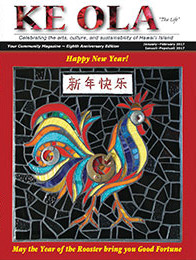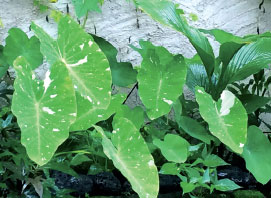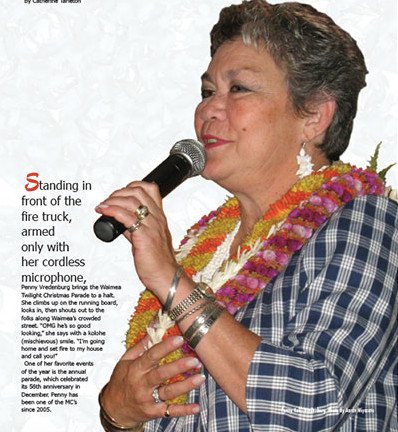
Habitat for Humanity
 By Karen Valentine
By Karen Valentine
To build a community takes more than money. Habitat for Humanity West Hawaii has come up with a term that is friendlier than fundraising. Want to make friends? Engage in a Friend-Raising activity with Habitat. This year, there are more ways than ever before to do this.
Because the need for affordable housing is growing, the board of directors and volunteer committees with Habitat have set an ambitious goal. In 2017, they want to build 14 homes for needy families with the help of hundreds of volunteers. This is a call to action to the entire community.
Habitat for Humanity West Hawaii, an affiliate with Habitat for Humanity International, has been serving low-income residents living on the west side of Hawai‘i Island from Hawi to South Point since 2002. This year, there are plans to expand to an island-wide organization, merging with the Hilo Habitat, says Isobel Donovan, deputy director.
Blitz Build—10 Homes in 10 Days
The local nonprofit organization is gearing up for their biggest year ever. From Sept. 13 to Sept. 23 it plans to hold a big “Blitz Build” with the ambitious goal of building 10 homes in 10 days! Building on a successful Blitz Build in 2012, when they had a huge outpouring of some 1,200 volunteer workers and completed five homes in five days, this year’s campaign is twice as big. Both initiatives are located in the Kona neighborhood of La‘i ‘Ōpua in the Kealakehe area. In partnership with the Department of Hawaiian Home Lands, they will put homes on DHHL lease lots for 10 qualified Hawaiian families. The remaining four homes, fulfilling the annual goal of 14 homes, will be spread throughout the region and throughout the year.
Blitz Builds are popular community events throughout the world, as they bring so many people together: volunteer construction workers, volunteers to do other things, the families who will be housed, donors of money, food, and materials, and members of Habitat’s Global Village—troupes of volunteers from other locations who fly in to help out. “It’s a huge event,” says Isobel. “We have to come up with all of the funding of the homes up front, as well as all of the logistics to get it done. We’ll use all volunteer labor, except for three paid project management staff members and paid subcontractors in skilled trades like electrical and plumbing. There should be lots of community volunteers to organize. We bring in Global Village teams from across the country who will spend the week with us.”
Families who qualify to receive a home through a rigorous application process are also required to contribute 500 volunteer hours themselves to complete the task and receive the keys to their own new front door.

The Appleseed Foundation in Hawai‘i provides housing data and needs. “It’s a sad situation and it’s getting a lot worse,” Isobel says. According to the data, Hawai‘i has one of the highest costs of living, poverty, and homeless rates in the country. It has also one of the lowest rates of homeownership. In Hawai‘i County, there are 6,000 families on the waitlist for public housing with a six-to-seven-year wait time. It’s determined that $65,600 is the annual income needed to afford Fair Market Rent here.
We know the need is increasing because every time we put out an offering, the number of people attending [our presentation] escalates. We know we make a huge impact. The families we deal with make from 30 to 80 percent of the area median annual income, which means $29,000 to $60,000 for a family of four. They have to be employed and be able to pay around $450 to $550 monthly mortgage payments. DHHL lots are leased to them for $1 a year.”
A Habitat mortgage is designed so that no family is paying more than 30 percent of their monthly income on their housing. In this way, Habitat stands out from other providers of low-income housing. Its programs typically help those who fall through the gap.
Land for the house that isn’t on a lease arrangement is either owned by the family or acquired by Habitat and sold to the family as a component of the mortgage, which is structured on a no-interest, no-profit basis and requiring only a 1-percent down payment. Families, who become “partner families,” are required to contribute “sweat equity” during the building process. The Family Support component of the Habitat program provides assistance with budgeting, house repair, and maintenance for the duration of the mortgage. The organization’s goal is to break the cycle of poverty for its partner families, helping them to acquire an asset that they can pass on to their children. All mortgage payments are put into a revolving “Fund for Humanity,” which is used to build new homes for other families in need, thereby allowing each partner family to “pay it forward.”
“A new initiative for us is building homes in Waikoloa Village, where we bought six lots,” Isobel says. “It’s an affordable workforce housing program in partnership with the county. One of the criteria for these families is that they drive more than 30 miles to work each way, and most drive much farther.”
The first family selected for the 2017 Blitz Build is the Alvarez-Torres family: Kalani Sr. and Amber, with their two children, Sasha and Kalani Jr.
Amber is a general manager at Subway, which has donated lunches to Habitat’s volunteers and construction teams in the past. When she learned that Habitat would be doing a Blitz Build in 2017, she decided to apply for one of the ten available homes in the La‘i ‘Ōpua neighborhood.
“We want our kids to be able to focus on schooling, instead of on struggling to stay off the streets,” Amber says. The Alvarez-Torres family was struck with tragedy during their application process. Soon after the home visit, their 14-year old daughter became ill due to a bad reaction to medication. Destiny Alvarez-Torres was on a wait list for a bone marrow transplant when she passed away last spring.
Through the extreme hardship of losing a child, the Alvarez-Torres family received the news that they were approved for their Habitat home. Amber and her family now look forward to owning their own home for the first time ever.
Isobel tells the story of how it all began. “Habitat for Humanity West Hawaii started in 2002,” she recalls. “Lorraine Highkin got her friends together. She said come for dinner, and bring your checkbook.”
That started the ball rolling and it gained huge momentum, with Habitat for Humanity West Hawaii being granted international affiliation soon after. It began doing home repairs for people in need and built the first new home in 2005.
Building on the example of Lorraine Highkin, Habitat is creating social activities as a way to “friend-raise.” “Especially because we don’t have large corporate headquarters here to rely upon,” says Isobel. “We do small events to raise funds and make people more aware. For example, we recently started our successful Paint and Sip nights. A local artist comes in and teaches people how to paint. We had our first event at Humpy’s in Kona, and it sold out in three days. We’re going to do one every month. It’s a good girls’ night out! You get two drinks and take home an oil painting. There is also our annual golf tournament, this year planned to be at Hokuli‘a Golf Club on January 9. People can register on the website.”
The Grandest Garage Sale
“Since this year’s ambitious Blitz Build needs funding more than ever, some new strategies were needed,” says Isobel. “Every year, we have a development strategy for raising funds. This year, we also decided to hold a Grandest Garage Sale, March 10–12, including a preview night on Friday night with reception and auction. It’s building on what we do well with our retail stores. We will be collecting donations of larger and higher-end items. I think it will be a great event in the spirit of our Blitz Build. We have an additional storage unit in Kealakekua where people can drop off items. At the Hualalai and Kukio luxury home developments, we’ll have the big ReStore box trucks stationed in their complexes around the holidays to facilitate donations from the homeowners there,” she says.
New resident to the community, Natasha Green, is now a Habitat volunteer and came up with the garage sale idea. “Folks like me coming new to the island can furnish a home at dramatically reduced prices. I have bought literally everything from Habitat and garage sales,” she says. “We are hoping to have an art auction the evening of March 10 selling art re-imagined from recycled materials. We are looking for artists who would like to donate a piece. All donors will receive two invites to the Friday night event.”
The Grandest Garage Sale will take place in and around the retail Habitat for Humanity ReStore above Costco, just off Hina Lani Street. The store takes donations and sells items all year long, but this will be a special donation blitz. The new Kealakekua self-storage drop-off location will be ongoing. There is another ReStore on Kawaihae Road in Waimea.
“If people have a big item, we pick it up. We don’t accept clothes. It has to be furniture, household equipment, or appliances. We get building materials from construction people who bring in leftovers from their projects. When you spend money in a ReStore, you help someone in need,” says Natasha.
There is a year-round need for volunteers, not to mention the thousand-plus that will be needed this September.
“On an ongoing basis, we maintain about a dozen volunteers between the Re-Stores,” she says. “We also have an 11-member board of directors, building committee, family service committee, and a development committee. Our volunteer department has a construction manager and a couple of site supervisors for West Hawai‘i. On our website, there is a page for volunteers. We need people who can travel to all sides of the island to construction sites, we do an orientation program and work to retain them as volunteers. We are continually looking for volunteers as well as donors. Donations to the local organization stay here in the community 100 percent.”
Home remodeling is also a volunteer-fed initiative, serving in particular the growing population of seniors wishing to stay in their homes. Habitat West Hawaii joined the international Neighborhood Revitalization Program in 2011, and it’s already won national recognition from Habitat for Humanity International as a leader in the implementation of its efforts to end substandard housing on Hawai‘i Island. It has completed 24 critical home repairs to alleviate safety, health, and environmental concerns for more than 100 residents.
The organization has literally gone out and knocked on doors to find people to help, and many are too proud to ask for help.
Habitat for Humanity International’s most famous volunteer is former President Jimmy Carter. The organization, according to its website “was founded on the conviction that every man, woman and child should have a simple, durable place to live in dignity and safety, and that decent shelter in decent communities should be a matter of conscience and action for all.” ❖
All photos courtesy of Habitat for Humanity West
808.331.8010
Contact writer Karen Valentine: karenvalentine808@gmail.com


